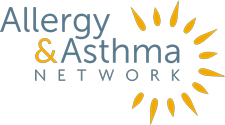
One family’s terrifying allergy experience takes them to Capitol Hill as advocates
By Allie Bahn
Imagine having your first allergic reaction while 30,000 feet up in the air. That’s what happened to Francine Ingrassia’s 10-year-old son Luca on an American Airlines flight from Aruba to Long Island in late February. Luca had never had an allergic reaction before in his life.
The family was served a bowl of warm nuts and beverages after takeoff. Luca ate a cashew and 10 minutes later said, “Mom, my stomach is killing me. I have cramps, chest pains and my throat is tickling me.”
Francine figured Luca needed an antihistamine. She asked a flight attendant for an antihistamine, but there wasn’t any on board. Francine quickly became concerned and explained that her son was having a reaction to the cashew.
“I started to panic,” says Francine.
Luca complained about breathing issues. Francine recalls, “I thought my son was going to suffocate.”
That’s when the flight attendant called for emergency medical assistance.
A nurse practitioner came to the front.
“She said that Luca was in stridor breathing, which means his lungs were starting to close,” explains Francine.
The nurse yelled out that she needed an epinephrine auto-injector and the airline staff made an announcement on the plane. Two passengers quickly came forward with their auto-injectors.
Francine was grateful for the passengers who helped so willingly. “I knew it was serious because the nurse practitioner was very worried as well,” Francine says. “I was a wreck. At the time I didn’t even know what kind of medicine was in the pens.”
Luca recovered thanks to the passengers who came forward.
But … what if no one had an epinephrine auto-injector on the flight?
Francine is making her voice heard on the importance of airlines carrying epinephrine auto-injectors on planes. “It’s a life or death situation,” she says. “The nurse practitioner and I are in contact and she verbally told me that Luca would NOT have made it without epinephrine.”
Currently, not all airlines carry epinephrine auto-injectors; some carry vials of epinephrine and syringes. This means someone on the airline staff needs to be trained how to fill the syringe and administer it. There is no guarantee that a passenger on board will know how to do this and not all airline staff are medically trained to administer epinephrine from a syringe. Meanwhile, epinephrine auto-injectors are designed for ease of use and no medical training is needed.
Francine recently started a petition asking legislators to sign a bill requiring airlines to carry epinephrine auto-injectors. The petition now has more than 98,000 signatures.
Francine will be among the participants at Allergy & Asthma Network’s 21st annual Allergy & Asthma Day Capitol Hill in Washington, D.C. on Wednesday, May 9. Allergy & Asthma Network supports legislative efforts to require airlines to carry epinephrine auto-injectors on all flights, as well as training for crewmembers to recognize anaphylaxis symptoms and administer the medication.
“We need to protect passengers on airline carriers and make sure everyone is safe. You cannot serve food and not be able to protect your passengers. In the skies there are no options, no ambulances and no guarantee that anyone can save you,” Francine says.
Francine also has concerns about anaphylaxis and epinephrine training among airline staff.
“They transferred us to our connecting flight instead of having an ambulance take my son to the hospital,” she says. “After any epinephrine injection you must go directly to a hospital. This means they are not properly trained for this type of an emergency.
“It’s common sense to have the staff trained to administer epinephrine auto-injectors. The training takes seconds to learn. I trained my entire family in seconds.”

 810304 Eaton Place, Suite 100
810304 Eaton Place, Suite 100